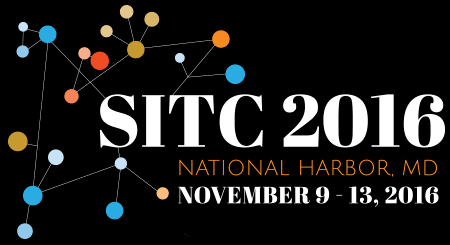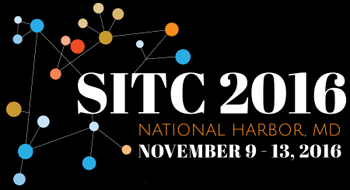Late-Breaking Abstracts Session I
Computational identification, functional characterization and antibody blockade of a new immune checkpoint in the TIGIT family of interacting molecules
In the first Late-Breaking Abstract (LBA) presentation of the meeting, Dr. John Hunter PhD (Compugen Inc.) recognized the advances made by attendees in developing anti-CTLA-4 and anti-PD-1 checkpoint inhibitors, but acknowledged that many patients do not achieve long-term benefit with these treatments. Underscoring the need for new immune checkpoints, Dr. Hunter explained how an international Compugen team used proprietary computational algorithms to identify a potential new T cell checkpoint, PVRIG, a member of the TIGIT molecular family that is expressed on T cells and NK cells and upregulated in human and murine tumors. Having confirmed PVRL2 as the PVRIG ligand using surface plasmon resonance (SPR), ELISA, and fluorescence-activated cell sorting (FACS), the group developed a high affinity antibody, COM-701, which enhanced CD4+ and CD8+ T cell proliferation in vitro. In subsequent studies using a CT26 mouse model of colorectal cancer, PVRIG blockade combined with anti-PD-1 therapy significantly reduced tumor growth (p=0.0005; 56% tumor growth inhibition). Similarly encouraging tumor growth inhibition was also observed in a MC38 knockout mouse model.
Combinatorial CD8+ and PD-L1+ cell densities correlate with response and improved survival in NSCLC patients treated with durvalumab
A presentation by Sonja Althammer, PhD (Definiens AG) addressed the prognostic potential of CD8+ and PD-L1+ tumor cell densities in determining treatment response to anti-PD-L1 therapy (durvalumab). Automated image analysis of cell densities in pre-treatment non-small cell lung (NSCLC) tumor samples from 163 patients (77% previously treated) subsequently treated with durvalumab showed that high combined CD8+/PD-L1+ cell densities (≥25% cells with membrane staining; n=26) had higher overall response rate (ORR=42%; 95% CI: 23, 63) than those with low combined baseline densities (ORR=7%, 95% CI: 2, 17). A high proportion of combined CD8+/PD-L1+ cell densities was also associated with longer overall survival (OS) (median OS=24.3 months; 95% CI: 14.5, NR), and progression-free survival (PFS) (median PFS=7.3 months; 95% CI: 4.0, 7.9) compared to high density of CD8+ cells (median OS=17.8 months; 95% CI: 14.0, Not Reached [NR]; median PFS=5.3 months; 95% CI: 3.1, 7.4) or PD-L1+ (median OS=17.1 months; 95% CI: 9.8, 25.3; median PFS=3.6 months; 95% CI: 2.6, 5.3) cells alone. These data indicate that tumors with a high proportion of CD8+ and PD-L1+ cells may be more likely to respond to immunotherapy; findings should be confirmed in an independent study.
Late-Breaking Abstracts Session II
KEYNOTE-045: Open-label, phase III study of pembrolizumab versus investigator’s choice of paclitaxel, docetaxel, or vinflunine for previously treated advanced urothelial carcinoma
In a highly anticipated presentation, Joaquim Bellmunt, MD, PhD (Dana-Farber/Brigham and Women’s Cancer Center) discussed a phase III trial of pembrolizumab (anti-PD-1) versus investigators’ choice of standard chemotherapy agents for the treatment of advanced urothelial carcinoma that progressed or recurred following platinum-based chemotherapy (NCT02256436). Although data for PD-L1 expression levels were collected, patients were enrolled regardless of PD-L1 status. This international study of 542 patients from 29 countries reported significantly longer overall survival in patients treated with pembrolizumab (HR 0.73, p=0.0022; median 10.3 vs. 7.4 months), and this was seen across all PD-L1 populations. Pembrolizumab treatment was also associated with fewer any-grade treatment-related adverse events compared to chemotherapy (60.9% vs. 90.2%). This trial, which was halted prematurely due to the markedly superior response in patients treated with pembrolizumab, supports pembrolizumab immunotherapy as a second-line treatment for patients in this disease setting.
Preliminary efficacy from a phase I/II study of the natural killer cell-targeted antibody, lirilumab in combination with nivolumab in squamous cell carcinoma of the head and neck
Rom Leidner, MD (Earle A. Chiles Research Institute) presented preliminary efficacy data from an early phase study of a first-in-class antibody, lirilumab, which blocks inhibitory killer-cell immunoglobulin-like receptors (KIR) on NK cells (NCT01714739). Following recent reports that combining lirilumab with nivolumab did not lead to greater toxicity than nivolumab alone, this study investigated lirilumab plus nivolumab in checkpoint inhibitor-naïve patients with squamous cell carcinoma of the head and neck that progressed after platinum-based chemotherapy. Of the evaluable patients thus far, 7/29 (24%) had an objective response per RECIST v1.1 criteria and none of the responders had HPV-positive oropharyngeal cancer. Target tumor lesion size decreased by >80% in 5/29 (17%) patients. Responses appeared durable in this ongoing trial as the median duration of response has not been reached. Analysis of PD-L1 expression in tumor samples showed a strong correlation between objective response and increasing level of PD-L1. Preliminary results of gene expression profiling revealed differential expression of genes associated with HLA, KIR, and T cells, although the implications of this have not yet been fully elucidated.
Efficacy and safety of nivolumab plus ipilimumab in metastatic urothelial carcinoma: first results from the phase I/II checkmate 032 study
Following the approval of nivolumab (anti-PD-1) in combination with ipilimumab (anti-CTLA-4) in advanced melanoma, the CheckMate 032 study seeks to expand use of this combination therapy into additional types of cancer. Padmanee Sharma, MD, PhD (University of Texas MD Anderson Cancer Center) presented the first interim data from two different dose schedules of ipilimumab and nivolumab (1mg/3mg vs. 3mg/1mg) or nivolumab alone in an open-label multicenter phase I/II trial (NCT01928394) in patients with advanced or metastatic urothelial cancer who progressed after treatment with platinum-based chemotherapy. Preliminary results of the combination strategy are very encouraging: patients in the nivo 1/ipi 3 arm had an objective response rate (ORR) of 38.5%, while ORR in the nivo 3/ipi 1 and nivolumab monotherapy arms were 26.0%, and 25.5%, respectively. Median overall survival (months [95% CI]) was also higher in the nivo 1/ipi 3 group (10.2 [4.5-not reached]) than the nivo 3/ipi 1 group (7.3 [5.6-11.4]). Side effects in the combination treatment groups were similar to those observed in other studies, with 30.8% of nivo 1/ipi 3 patients and 31.7% of nivo 3/ipi 1 patients experiencing a grade 3-4 treatment-related adverse event. Although enrollment is ongoing and longer follow-up is needed, these results support further development of the nivo 1/ipi 3 combination for treatment of metastatic urothelial cancer.





Important Dates
Regular Abstracts Published in JITC
November 8, 2016
Late-Breaking Abstracts Published in JITC
December 8, 2016
Thank You, Supporters!
Thank you, SITC 2016 supporters. Because of your generosity, SITC 2016 was a great success!
Interested in supporting other SITC programs? Confirm your support today!


Connect with SITC!